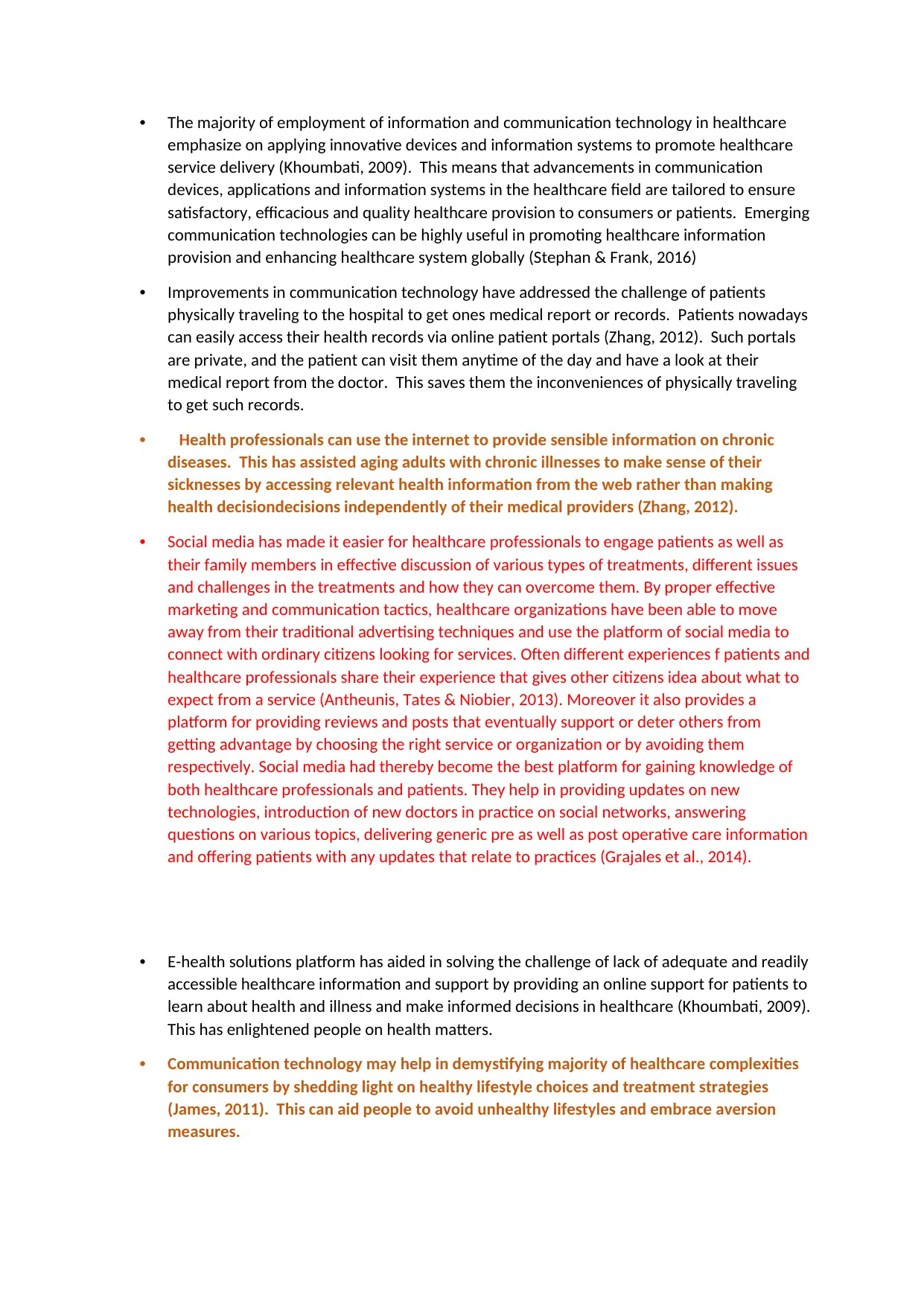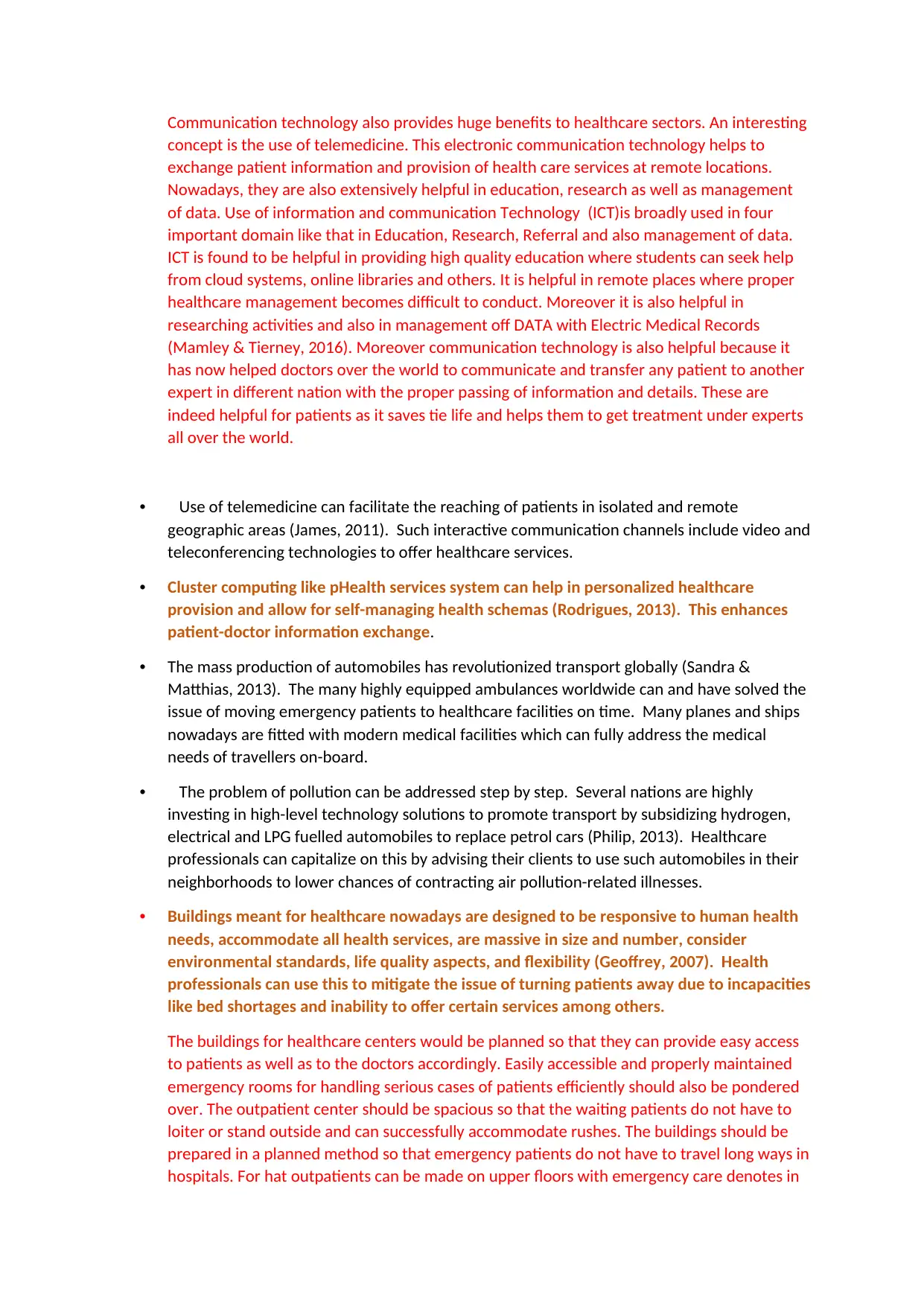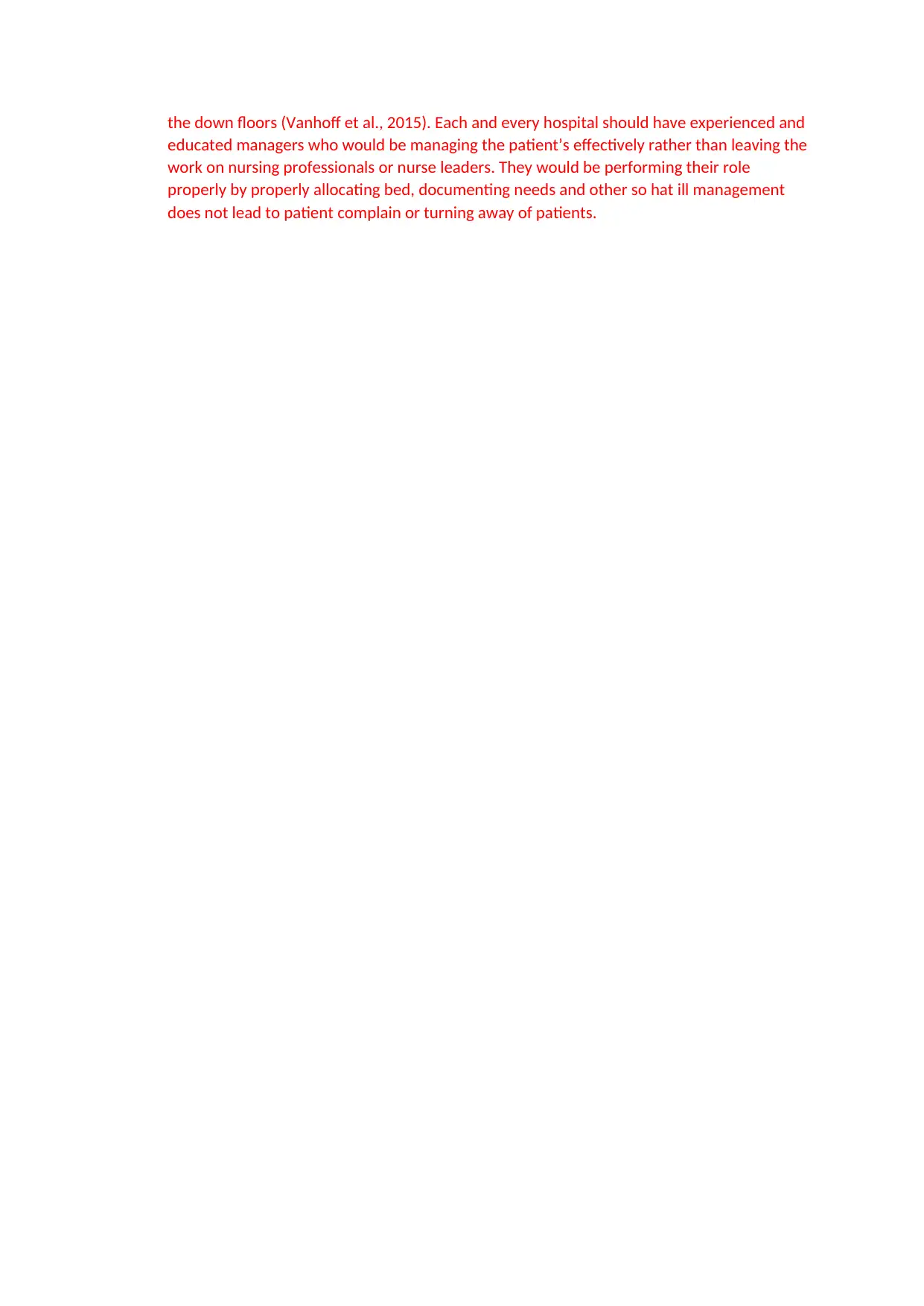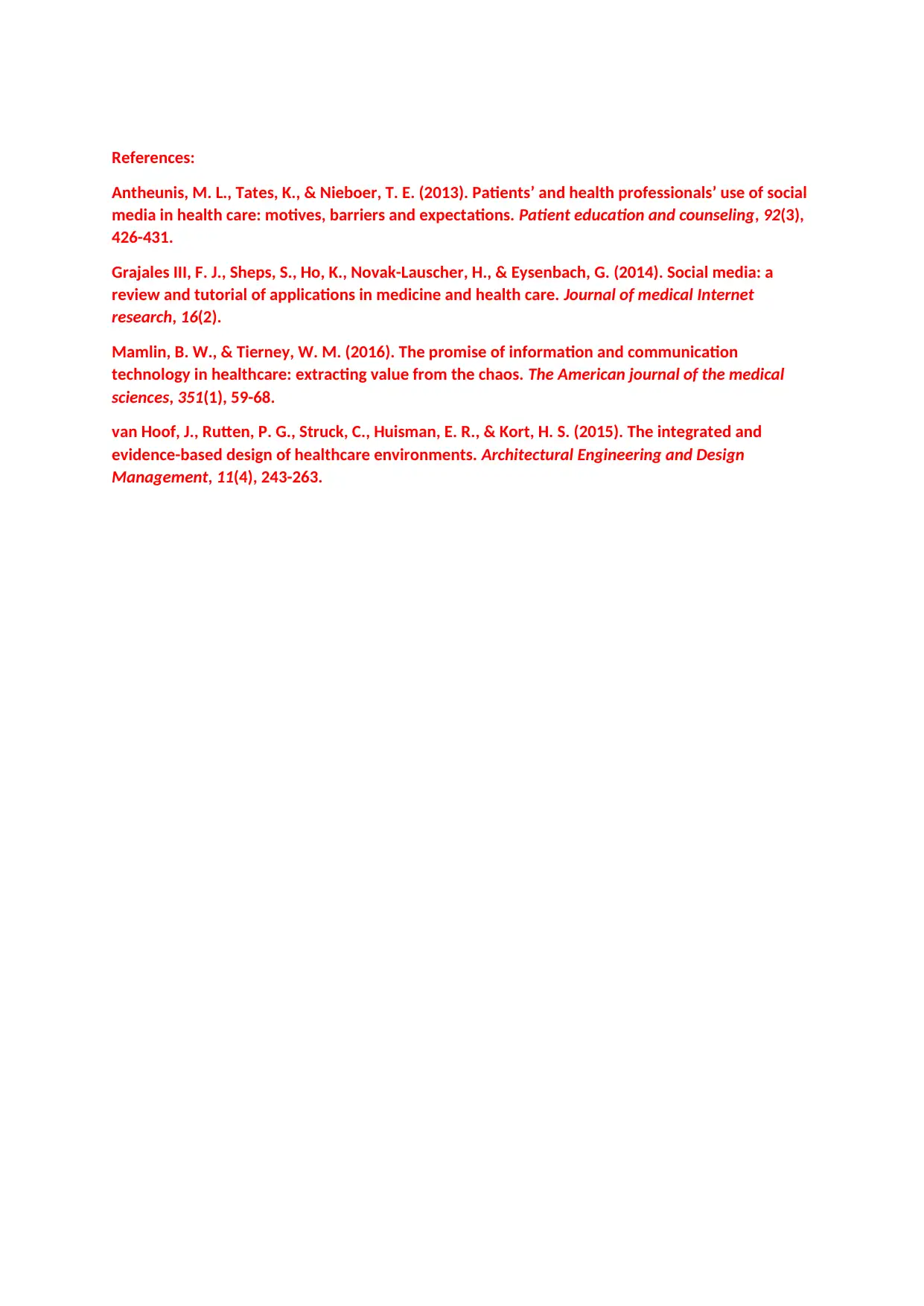Information and Communication Technology in Healthcare: An Overview
VerifiedAdded on 2020/03/02
|4
|1384
|200
Report
AI Summary
This report provides a comprehensive overview of the integration of Information and Communication Technology (ICT) in healthcare. It highlights the advancements in communication devices, applications, and information systems tailored to enhance healthcare service delivery and patient care. The report explores the benefits of online patient portals, telemedicine, and e-health solutions in improving patient access to health records, providing remote healthcare services, and facilitating communication between healthcare professionals and patients. It discusses the role of social media in engaging patients and sharing health information. Furthermore, the report examines how ICT aids in data management, research, and education within the healthcare sector. The use of technology in transportation, such as ambulances and medical facilities on transport, is also mentioned, along with the design of healthcare buildings to meet patient needs. The report concludes by emphasizing the importance of experienced management in healthcare facilities to ensure efficient patient care and address challenges like bed shortages.

• The majority of employment of information and communication technology in healthcare
emphasize on applying innovative devices and information systems to promote healthcare
service delivery (Khoumbati, 2009). This means that advancements in communication
devices, applications and information systems in the healthcare field are tailored to ensure
satisfactory, efficacious and quality healthcare provision to consumers or patients. Emerging
communication technologies can be highly useful in promoting healthcare information
provision and enhancing healthcare system globally (Stephan & Frank, 2016)
• Improvements in communication technology have addressed the challenge of patients
physically traveling to the hospital to get ones medical report or records. Patients nowadays
can easily access their health records via online patient portals (Zhang, 2012). Such portals
are private, and the patient can visit them anytime of the day and have a look at their
medical report from the doctor. This saves them the inconveniences of physically traveling
to get such records.
• Health professionals can use the internet to provide sensible information on chronic
diseases. This has assisted aging adults with chronic illnesses to make sense of their
sicknesses by accessing relevant health information from the web rather than making
health decisiondecisions independently of their medical providers (Zhang, 2012).
• Social media has made it easier for healthcare professionals to engage patients as well as
their family members in effective discussion of various types of treatments, different issues
and challenges in the treatments and how they can overcome them. By proper effective
marketing and communication tactics, healthcare organizations have been able to move
away from their traditional advertising techniques and use the platform of social media to
connect with ordinary citizens looking for services. Often different experiences f patients and
healthcare professionals share their experience that gives other citizens idea about what to
expect from a service (Antheunis, Tates & Niobier, 2013). Moreover it also provides a
platform for providing reviews and posts that eventually support or deter others from
getting advantage by choosing the right service or organization or by avoiding them
respectively. Social media had thereby become the best platform for gaining knowledge of
both healthcare professionals and patients. They help in providing updates on new
technologies, introduction of new doctors in practice on social networks, answering
questions on various topics, delivering generic pre as well as post operative care information
and offering patients with any updates that relate to practices (Grajales et al., 2014).
• E-health solutions platform has aided in solving the challenge of lack of adequate and readily
accessible healthcare information and support by providing an online support for patients to
learn about health and illness and make informed decisions in healthcare (Khoumbati, 2009).
This has enlightened people on health matters.
• Communication technology may help in demystifying majority of healthcare complexities
for consumers by shedding light on healthy lifestyle choices and treatment strategies
(James, 2011). This can aid people to avoid unhealthy lifestyles and embrace aversion
measures.
emphasize on applying innovative devices and information systems to promote healthcare
service delivery (Khoumbati, 2009). This means that advancements in communication
devices, applications and information systems in the healthcare field are tailored to ensure
satisfactory, efficacious and quality healthcare provision to consumers or patients. Emerging
communication technologies can be highly useful in promoting healthcare information
provision and enhancing healthcare system globally (Stephan & Frank, 2016)
• Improvements in communication technology have addressed the challenge of patients
physically traveling to the hospital to get ones medical report or records. Patients nowadays
can easily access their health records via online patient portals (Zhang, 2012). Such portals
are private, and the patient can visit them anytime of the day and have a look at their
medical report from the doctor. This saves them the inconveniences of physically traveling
to get such records.
• Health professionals can use the internet to provide sensible information on chronic
diseases. This has assisted aging adults with chronic illnesses to make sense of their
sicknesses by accessing relevant health information from the web rather than making
health decisiondecisions independently of their medical providers (Zhang, 2012).
• Social media has made it easier for healthcare professionals to engage patients as well as
their family members in effective discussion of various types of treatments, different issues
and challenges in the treatments and how they can overcome them. By proper effective
marketing and communication tactics, healthcare organizations have been able to move
away from their traditional advertising techniques and use the platform of social media to
connect with ordinary citizens looking for services. Often different experiences f patients and
healthcare professionals share their experience that gives other citizens idea about what to
expect from a service (Antheunis, Tates & Niobier, 2013). Moreover it also provides a
platform for providing reviews and posts that eventually support or deter others from
getting advantage by choosing the right service or organization or by avoiding them
respectively. Social media had thereby become the best platform for gaining knowledge of
both healthcare professionals and patients. They help in providing updates on new
technologies, introduction of new doctors in practice on social networks, answering
questions on various topics, delivering generic pre as well as post operative care information
and offering patients with any updates that relate to practices (Grajales et al., 2014).
• E-health solutions platform has aided in solving the challenge of lack of adequate and readily
accessible healthcare information and support by providing an online support for patients to
learn about health and illness and make informed decisions in healthcare (Khoumbati, 2009).
This has enlightened people on health matters.
• Communication technology may help in demystifying majority of healthcare complexities
for consumers by shedding light on healthy lifestyle choices and treatment strategies
(James, 2011). This can aid people to avoid unhealthy lifestyles and embrace aversion
measures.
Paraphrase This Document
Need a fresh take? Get an instant paraphrase of this document with our AI Paraphraser

Communication technology also provides huge benefits to healthcare sectors. An interesting
concept is the use of telemedicine. This electronic communication technology helps to
exchange patient information and provision of health care services at remote locations.
Nowadays, they are also extensively helpful in education, research as well as management
of data. Use of information and communication Technology (ICT)is broadly used in four
important domain like that in Education, Research, Referral and also management of data.
ICT is found to be helpful in providing high quality education where students can seek help
from cloud systems, online libraries and others. It is helpful in remote places where proper
healthcare management becomes difficult to conduct. Moreover it is also helpful in
researching activities and also in management off DATA with Electric Medical Records
(Mamley & Tierney, 2016). Moreover communication technology is also helpful because it
has now helped doctors over the world to communicate and transfer any patient to another
expert in different nation with the proper passing of information and details. These are
indeed helpful for patients as it saves tie life and helps them to get treatment under experts
all over the world.
• Use of telemedicine can facilitate the reaching of patients in isolated and remote
geographic areas (James, 2011). Such interactive communication channels include video and
teleconferencing technologies to offer healthcare services.
• Cluster computing like pHealth services system can help in personalized healthcare
provision and allow for self-managing health schemas (Rodrigues, 2013). This enhances
patient-doctor information exchange.
• The mass production of automobiles has revolutionized transport globally (Sandra &
Matthias, 2013). The many highly equipped ambulances worldwide can and have solved the
issue of moving emergency patients to healthcare facilities on time. Many planes and ships
nowadays are fitted with modern medical facilities which can fully address the medical
needs of travellers on-board.
• The problem of pollution can be addressed step by step. Several nations are highly
investing in high-level technology solutions to promote transport by subsidizing hydrogen,
electrical and LPG fuelled automobiles to replace petrol cars (Philip, 2013). Healthcare
professionals can capitalize on this by advising their clients to use such automobiles in their
neighborhoods to lower chances of contracting air pollution-related illnesses.
• Buildings meant for healthcare nowadays are designed to be responsive to human health
needs, accommodate all health services, are massive in size and number, consider
environmental standards, life quality aspects, and flexibility (Geoffrey, 2007). Health
professionals can use this to mitigate the issue of turning patients away due to incapacities
like bed shortages and inability to offer certain services among others.
The buildings for healthcare centers would be planned so that they can provide easy access
to patients as well as to the doctors accordingly. Easily accessible and properly maintained
emergency rooms for handling serious cases of patients efficiently should also be pondered
over. The outpatient center should be spacious so that the waiting patients do not have to
loiter or stand outside and can successfully accommodate rushes. The buildings should be
prepared in a planned method so that emergency patients do not have to travel long ways in
hospitals. For hat outpatients can be made on upper floors with emergency care denotes in
concept is the use of telemedicine. This electronic communication technology helps to
exchange patient information and provision of health care services at remote locations.
Nowadays, they are also extensively helpful in education, research as well as management
of data. Use of information and communication Technology (ICT)is broadly used in four
important domain like that in Education, Research, Referral and also management of data.
ICT is found to be helpful in providing high quality education where students can seek help
from cloud systems, online libraries and others. It is helpful in remote places where proper
healthcare management becomes difficult to conduct. Moreover it is also helpful in
researching activities and also in management off DATA with Electric Medical Records
(Mamley & Tierney, 2016). Moreover communication technology is also helpful because it
has now helped doctors over the world to communicate and transfer any patient to another
expert in different nation with the proper passing of information and details. These are
indeed helpful for patients as it saves tie life and helps them to get treatment under experts
all over the world.
• Use of telemedicine can facilitate the reaching of patients in isolated and remote
geographic areas (James, 2011). Such interactive communication channels include video and
teleconferencing technologies to offer healthcare services.
• Cluster computing like pHealth services system can help in personalized healthcare
provision and allow for self-managing health schemas (Rodrigues, 2013). This enhances
patient-doctor information exchange.
• The mass production of automobiles has revolutionized transport globally (Sandra &
Matthias, 2013). The many highly equipped ambulances worldwide can and have solved the
issue of moving emergency patients to healthcare facilities on time. Many planes and ships
nowadays are fitted with modern medical facilities which can fully address the medical
needs of travellers on-board.
• The problem of pollution can be addressed step by step. Several nations are highly
investing in high-level technology solutions to promote transport by subsidizing hydrogen,
electrical and LPG fuelled automobiles to replace petrol cars (Philip, 2013). Healthcare
professionals can capitalize on this by advising their clients to use such automobiles in their
neighborhoods to lower chances of contracting air pollution-related illnesses.
• Buildings meant for healthcare nowadays are designed to be responsive to human health
needs, accommodate all health services, are massive in size and number, consider
environmental standards, life quality aspects, and flexibility (Geoffrey, 2007). Health
professionals can use this to mitigate the issue of turning patients away due to incapacities
like bed shortages and inability to offer certain services among others.
The buildings for healthcare centers would be planned so that they can provide easy access
to patients as well as to the doctors accordingly. Easily accessible and properly maintained
emergency rooms for handling serious cases of patients efficiently should also be pondered
over. The outpatient center should be spacious so that the waiting patients do not have to
loiter or stand outside and can successfully accommodate rushes. The buildings should be
prepared in a planned method so that emergency patients do not have to travel long ways in
hospitals. For hat outpatients can be made on upper floors with emergency care denotes in

the down floors (Vanhoff et al., 2015). Each and every hospital should have experienced and
educated managers who would be managing the patient’s effectively rather than leaving the
work on nursing professionals or nurse leaders. They would be performing their role
properly by properly allocating bed, documenting needs and other so hat ill management
does not lead to patient complain or turning away of patients.
educated managers who would be managing the patient’s effectively rather than leaving the
work on nursing professionals or nurse leaders. They would be performing their role
properly by properly allocating bed, documenting needs and other so hat ill management
does not lead to patient complain or turning away of patients.
⊘ This is a preview!⊘
Do you want full access?
Subscribe today to unlock all pages.

Trusted by 1+ million students worldwide

References:
Antheunis, M. L., Tates, K., & Nieboer, T. E. (2013). Patients’ and health professionals’ use of social
media in health care: motives, barriers and expectations. Patient education and counseling, 92(3),
426-431.
Grajales III, F. J., Sheps, S., Ho, K., Novak-Lauscher, H., & Eysenbach, G. (2014). Social media: a
review and tutorial of applications in medicine and health care. Journal of medical Internet
research, 16(2).
Mamlin, B. W., & Tierney, W. M. (2016). The promise of information and communication
technology in healthcare: extracting value from the chaos. The American journal of the medical
sciences, 351(1), 59-68.
van Hoof, J., Rutten, P. G., Struck, C., Huisman, E. R., & Kort, H. S. (2015). The integrated and
evidence-based design of healthcare environments. Architectural Engineering and Design
Management, 11(4), 243-263.
Antheunis, M. L., Tates, K., & Nieboer, T. E. (2013). Patients’ and health professionals’ use of social
media in health care: motives, barriers and expectations. Patient education and counseling, 92(3),
426-431.
Grajales III, F. J., Sheps, S., Ho, K., Novak-Lauscher, H., & Eysenbach, G. (2014). Social media: a
review and tutorial of applications in medicine and health care. Journal of medical Internet
research, 16(2).
Mamlin, B. W., & Tierney, W. M. (2016). The promise of information and communication
technology in healthcare: extracting value from the chaos. The American journal of the medical
sciences, 351(1), 59-68.
van Hoof, J., Rutten, P. G., Struck, C., Huisman, E. R., & Kort, H. S. (2015). The integrated and
evidence-based design of healthcare environments. Architectural Engineering and Design
Management, 11(4), 243-263.
1 out of 4
Related Documents
Your All-in-One AI-Powered Toolkit for Academic Success.
+13062052269
info@desklib.com
Available 24*7 on WhatsApp / Email
![[object Object]](/_next/static/media/star-bottom.7253800d.svg)
Unlock your academic potential
Copyright © 2020–2025 A2Z Services. All Rights Reserved. Developed and managed by ZUCOL.





